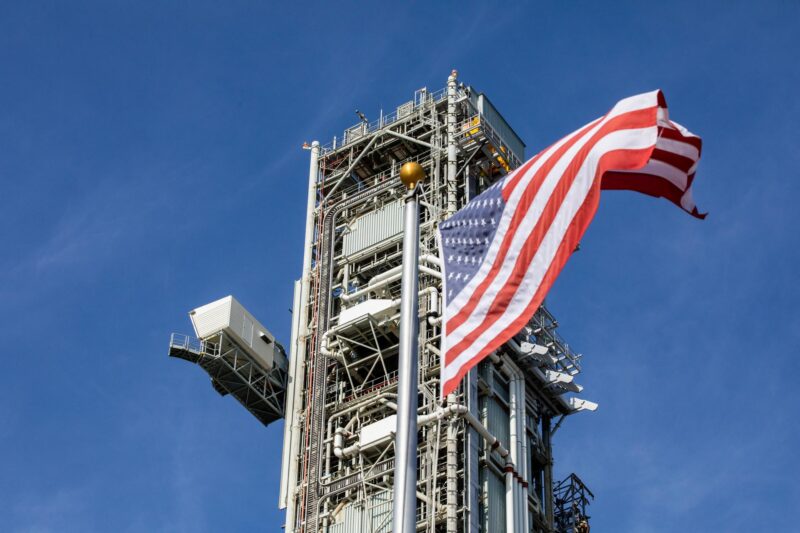
Last Wednesday, NASA transported the towering Mobile Launcher for its Space Launch System (SLS) rocket to Launch Complex 39B. This event was the latest step towards the launch of the historic Artemis 2 mission, which is currently slated for November of 2024. The relocation of the Mobile Launcher marks the beginning of a comprehensive multi-month series of tests for the structure and its launch pad. This testing will verify that the SLS’ ground-based support equipment is ready to support the launch of Artemis 2.
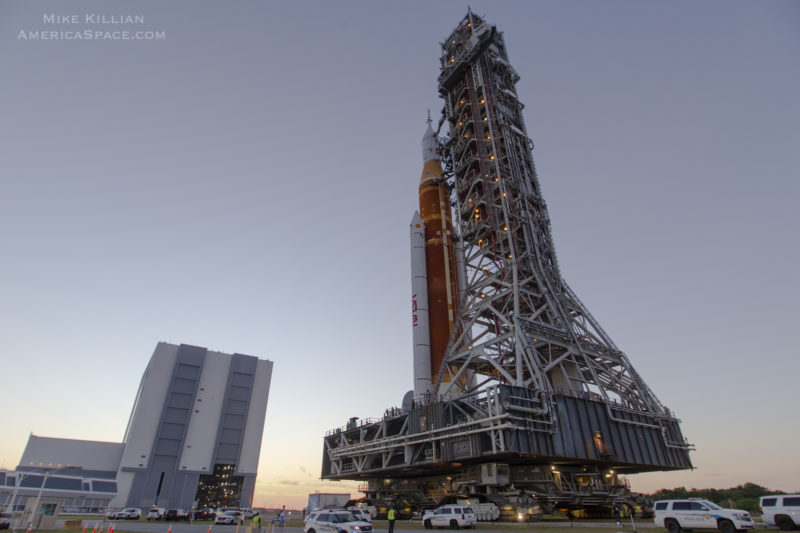
The Mobile Launcher (ML) is a marvel of engineering. Its square base can support a 2,600-ton SLS booster, and its tower extends 402 feet (122 meters) above ground level. However, unlike a typical 40-story building, the ML can be relocated. During a launch campaign, an SLS is stacked on top of the ML’s base inside the iconic Vehicle Assembly Building (VAB). The ML is then carried to the launch pad by one of NASA’s two Crawler-Transporters. These machines have been in service since the first launch of the Saturn V, and they remain the world’s largest self-propelled land vehicles. These statistics are impressive enough, but the ML is more than just a tower. It contains a complex array of plumbing which loads cryogenic liquid hydrogen and liquid oxygen into the SLS. Additionally, it allows technicians to inspect the entire surface of the rocket, and it allows astronauts to board the Orion spacecraft.
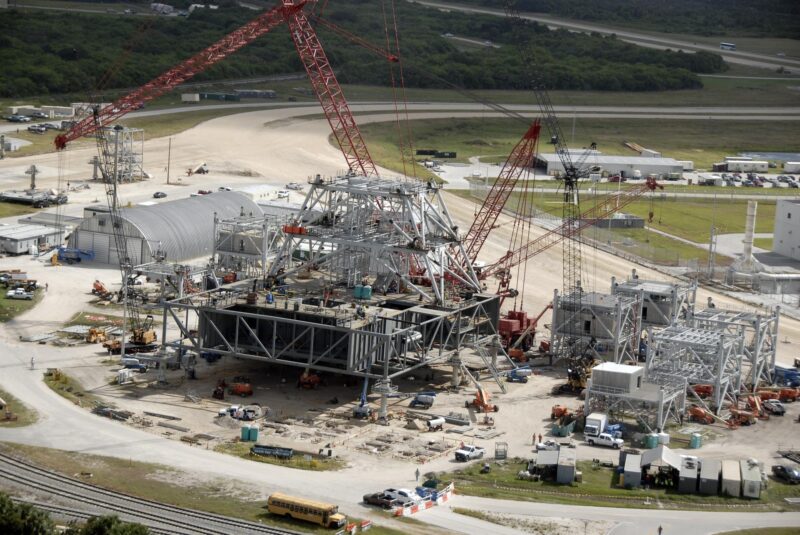
The Mobile Launcher is essential to the success of Artemis 2. The tower and its designers endured a convoluted series of events to reach this point. The ML was originally built to support the Constellation Program’s Ares I rocket. Construction began in February of 2009. The entire ML was completed within a year for a cost of 234 million dollars [1], which are both impressive figures for a major aerospace project. However, Constellation was abruptly cancelled just a month later, which left the ML as a launch platform without a rocket.
The structure was rescued from demolition when NASA elected to repurpose it for the SLS program. At the time, it was projected that reusing the ML would be cheaper ($54 million) than building a new tower. That is where the Mobile Launcher’s troubles began. The Ares I produced just 40% of the thrust of the SLS, so the ML required extensive structural reinforcements. Additionally, it required new mechanical arms to load propellant into the new rocket’s capacious tanks, as well as new plumbing to accommodate the larger fuel load.
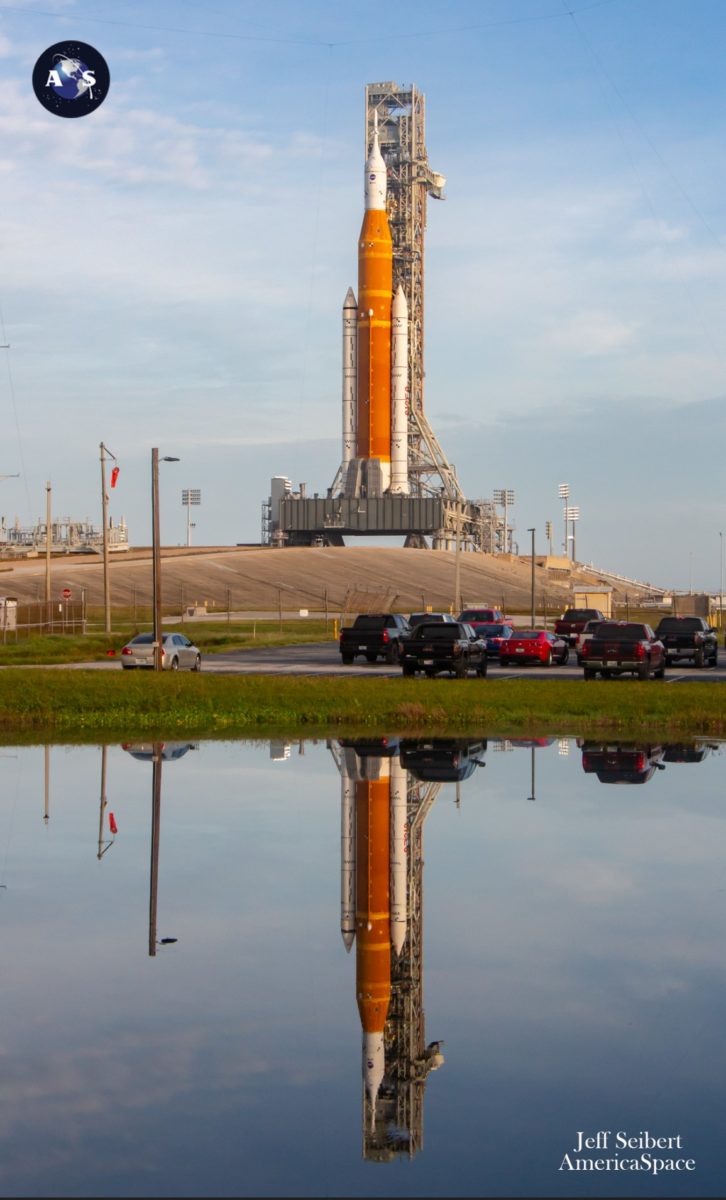
Installing all of this hardware while keeping the tower under its weight limit proved to be exceedingly difficult. The modifications cost 693 million dollars and took seven years [1]. Additionally, the new equipment placed unanticipated strains on the tower’s structure. It began leaning slightly, drawing unwelcome comparisons to the Leaning Tower of Pisa. However, the work was ultimately successful. After two rounds of testing in 2018 and 2019, the Mobile Launcher supported the Artemis 1 launch campaign. Artemis 1 yielded multiple key lessons about how to transfer cryogenic propellants from the ML into the SLS. The procedures developed throughout this process should benefit Artemis 2 and subsequent missions by minimizing the hydrogen leaks which plagued Artemis 1.
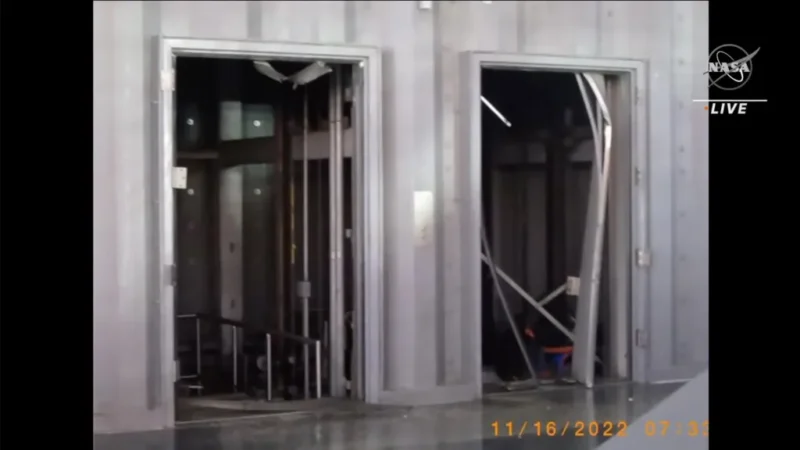
Following the launch of Artemis 1, engineers spent nine months repairing and upgrading the ML. During this period, the tower was parked on top of four pillars outside the Vehicle Assembly Building. During Artemis 1, the SLS’ main engines and Solid Rocket Boosters (SRBs) produced 8.8 million pounds of thrust, which triumphantly crowned it as the most powerful rocket to ever reach orbit. This record-setting amount of thrust caused more damage than computer simulations had predicted.
Most notably, the rocket’s exhaust plume tore away the doors of the two elevators which grant access to the tower’s various levels. Other impacts of the launch included paint peeling away from the tower and damage to the pneumatic lines which load nitrogen and helium into the rocket. Mission Manager Mike Sarafin noted, “We had accounted for that (damage) previously in our plan and our budget for the time between Artemis 1 and 2.” [2] The Exploration Ground Systems team meticulously repaired the damage while also treating the corrosion which is produced by the acidic exhaust of the SRBs.
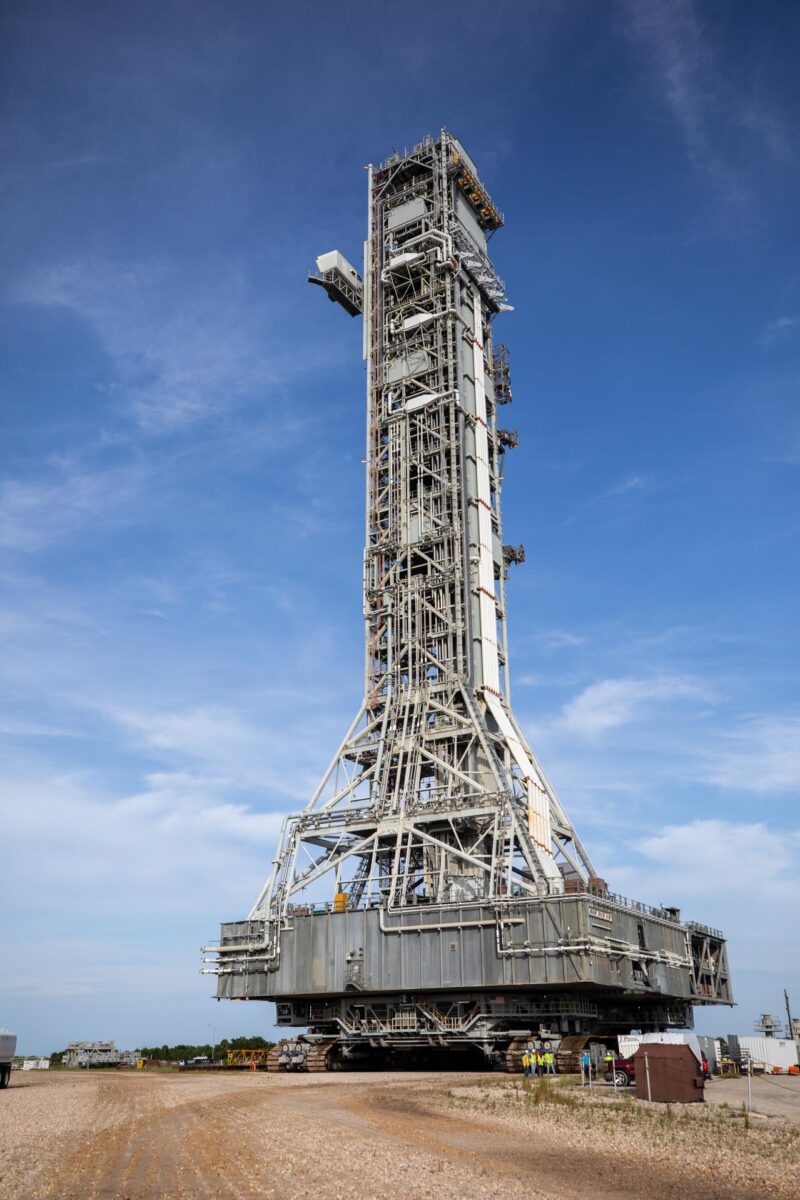
All of this work culminated in the rollout of the Mobile Launcher on Wednesday, August 17th. A Crawler-Transporter carried the empty launch mount and tower along the 4.5-mile gravel road which leads from the VAB to Pad 39B at the leisurely pace of 0.8 miles per hour. The purpose of the trip is to test several systems which were installed after the launch of Artemis 1. It is unclear how long the ML will remain at the launch pad, although the tests will likely last several months. The tests will verify that Artemis 2 crewmembers Reid Wiseman, Victor Glover, Christina Koch, and Jeremy Hansen can safely approach a fully-fueled SLS and board their spacecraft. It is also arguably the first milestone in Artemis 2’s launch processing flow, as NASA will begin stacking SLS components on top of the ML after it returns from the pad.
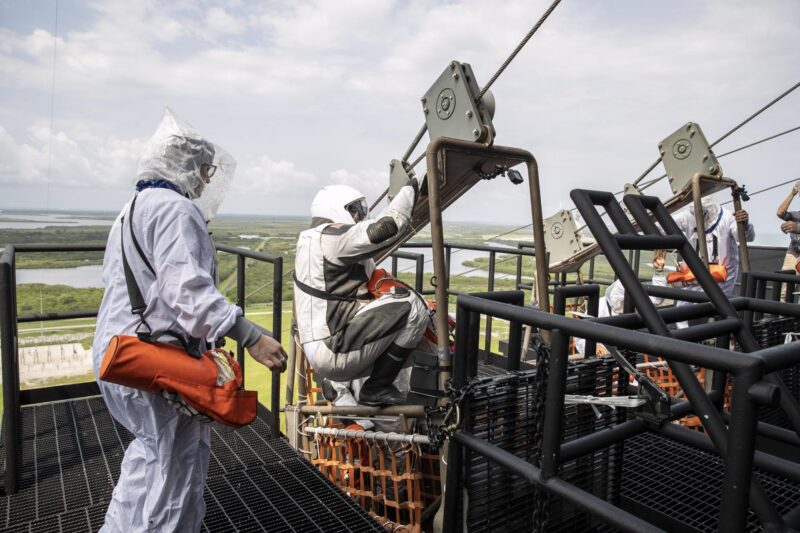
The primary focus of the upcoming testing will be the Emergency Egress System. If an emergency, such as a fire or a toxic gas leak, arises at the launch pad, Wiseman’s crew and their support team will need to exit the area as quickly as possible. NASA originally planned to whisk them to safety in a roller coaster-like structure, which was studied in partnership with the Disney corporation [3]. Ultimately, the agency opted to use safer and cheaper (if less flamboyant) slidewire baskets. These metal baskets will slide down a large cable until they are caught by a net near the perimeter of the launch pad. The astronauts can then shelter inside a bunker or driving to safety inside a Mine-Resistant Armored Protection (MRAP) vehicle.
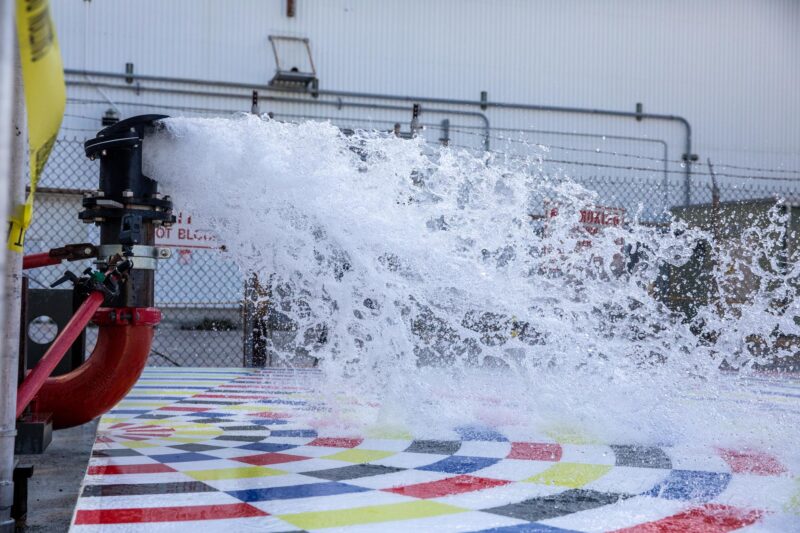
While a similar system was employed during the Space Shuttle program, the Artemis missions will use larger baskets which can evacuate more people. The bunker has been renovated, and a new cable system is being used to keep the baskets’ velocities within a reasonable range as they descend from the apex of the massive launch tower. All of this equipment will be put through its paces over the coming months. The Exploration Ground Systems team will begin by attaching the cables to a new platform which was recently installed on top of the Mobile Launcher. Since the tower is mobile, this procedure will need to be performed prior to every launch. The engineers will then release the slidewire baskets from the top of the tower. As they travel down the cable, a suite of sensors will measure the forces which a passenger would experience during an evacuation.
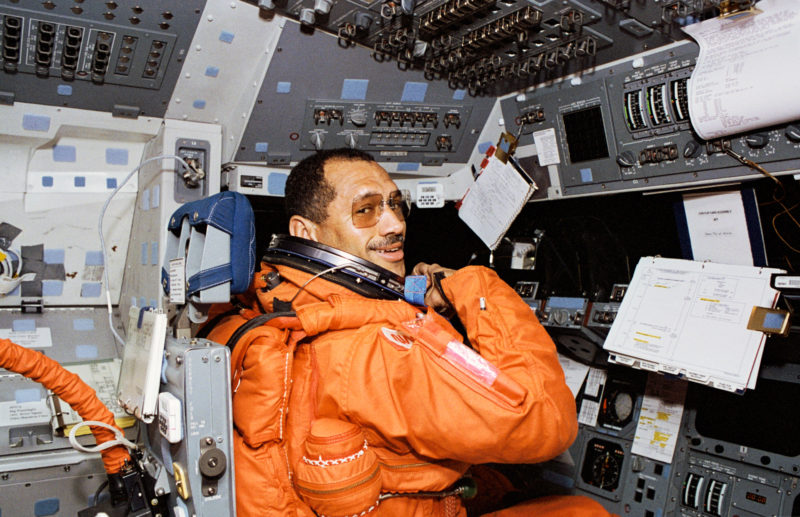
Sandbags will initially be used to simulate the mass of a group of suited astronauts. However, NASA has not disclosed whether any humans will experience this exhilarating ride. Out of an abundance of caution, the Shuttle’s egress system was typically tested without any passengers. The one exception to this rule was Charlie Bolden, a distinguished Shuttle commander and future NASA Administrator. Following the Challenger tragedy, a new set of requirements mandated that the baskets be certified with a human passenger. Bolden was assigned to complete this task. Military astronauts frequently tease each other over interservice rivalries, so Bolden’s Air Force and Navy colleagues joked that “We sent a Marine to confirm that the baskets were safe for sandbags.”
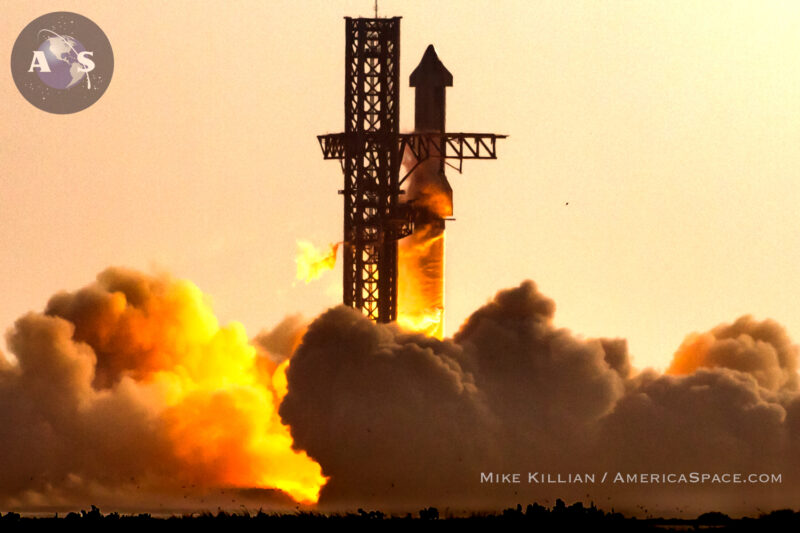
A second area of focus will be the Mobile Launcher’s Sound Suppression System. To blunt the intense pressure waves from the SRBs, this system of pipes releases 450,000 gallons (1,700,000 liters) of water in a matter of seconds. The deluge absorbs the bulk of the heat and sound released during the launch. Sound suppression has been a headache for heavy-lift rockets in recent months. Alongside Artemis 1, SpaceX’s titanic Starship booster caused extensive damage to its launch pad. The rocket dug a 30-foot-deep crater underneath the launch pad, flinging concrete boulders thousands of feet in every direction. In their final moments, AmericaSpace’s remote cameras captured an apocalyptic scene as a torrent of dust and debris accelerated away from the site. Computers are clearly incapable of simulating marvels of technology such as SLS and Starship. Even before Artemis 1, NASA was planning to install a new system of “rainbird” nozzles to protect the SLS launch pad. This system will be tested during the Mobile Launcher’s stint at Pad 39B.
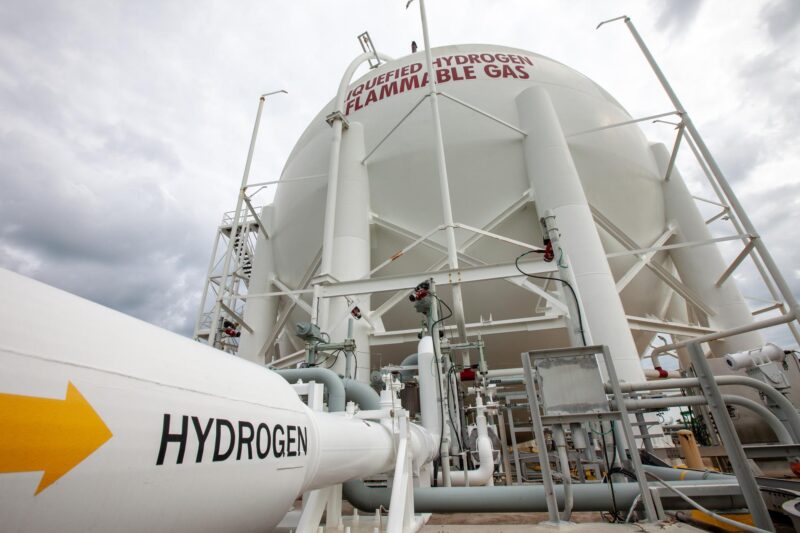
Finally, NASA will perform initial testing on a new liquid hydrogen storage tank. This massive insulated sphere is capable of storing 1.2 million gallons of hydrogen at -423 degrees Fahrenheit (-253 degrees Celsius). Its volume will allow NASA to schedule SLS launch attempts on consecutive days. This capability will help the launch control team work around poor weather while increasing the probability that Artemis 2 will launch during a given two-week launch window. The new liquid hydrogen tank was not available for Artemis 1, so the Exploration Ground Systems team would like to demonstrate its capabilities prior to Artemis 2. Since the ML is not currently harboring a rocket, the launch pad lacks a receptacle for liquid hydrogen. However, engineers will pressurize the propellant lines which lead to the rocket and check for leaks [4].
At some point during the test campaign, Wiseman, Glover, Koch, and Hansen will visit the launch pad. They will familiarize themselves with the Mobile Launcher, the slidewire baskets, and the Crew Access Arm which they will use to board Orion. Exploration Ground Systems Program Manager Shawn Quinn projected that the current test series will conclude in December. The Mobile Launcher will then be transported back to the VAB in preparation for the assembly of the Artemis 2 SLS stack, which will commence in February. Launch Complex 39B is the pier from which the explorers of the “Artemis Generation” will set sail. The testing which is underway will confirm that it is ready to serve as the stage for their bold voyages of discovery.
Missions » SLS »



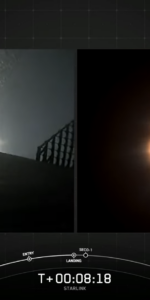

2 Comments
2 Pings & Trackbacks
Pingback:2024: Year of the Moon - AmericaSpace
Pingback:2024: Year of the Moon - SPACERFIT